
试卷代号:1066 中央广播电视大学2008一2009学年度第一学期“开放本科”期末考试 语言与应用语言学试题 2009年1月 注意事项 一、将你的学号、姓名及分校(工作站)名称填写在答题纸的规定栏 内。考试结束后,把试卷和答题纸放在桌上。试卷和答题纸均不得带 出考场。 二、仔细阅读题目的说明,并按题目要求答题。答案一定要写在答 题纸指定的位置上,写在试卷上的答案无效。 三、用蓝、黑圆珠笔或钢笔答题,使用铅笔答题无效。 You have 90 minutes to finish this exam. .The exam consists of four sections: Section 1 Checking content awareness of the course I.Multiple Choice Questions (10 items,20 points,2 points for each item) II.Gap-filling (10 items,20 points,2 for each item) Section 2 Checking understanding of some general principles of language and linguistics III.True or False Questions (10 items,20 points,2 points for each item) IV.Matching (10 items,20 points,2 points for each item) Section 3 Checking analytic application (1 item,20 points) V.One analytic question about some linguistic phenomena This is a closed exam.You are not allowed to consult any reference books or with other examinees. 503
试卷代号 :1066 中央广播电视大学2008-2009学年度第一学期“开放本科”期末考试 语言与应用语言学 试题 2009年 1月 注 意 事 项 一、将你的学号、姓名及分校(工作站)名称填写在答题纸的规定栏 内。考试结束后,把试卷和答题纸放在桌上。试卷和答题纸均不得带 出考场。 二、仔细阅读题 目的说明,并按题目要求答题。答案一定要写在答 题纸指定的位置上,写在试卷上的答案无效。 三、用蓝、黑圆珠笔或钢笔答题,使用铅笔答题无效。 . You have 90 minutes to finish this exam. . The exam consists of four sections: Section 1 Checking content awareness of the course I.Multiple Choice Questions(10 items,20 points,2 points for each item) I.Gap-filling(10 items,20 points,2 for each item) Section 2 Checking understanding of some general principles of language and linguistics fu.True or False Questions(10 items,20 points,2 points for each item) N.Matching(10 items,20 points,2 points for each item) Section 3 Checking analytic application(1 item,20 points) V.One analytic question about some linguistic phenomena . This is a closed exam. You are not allowed to consult any reference books or with other examinees. 503
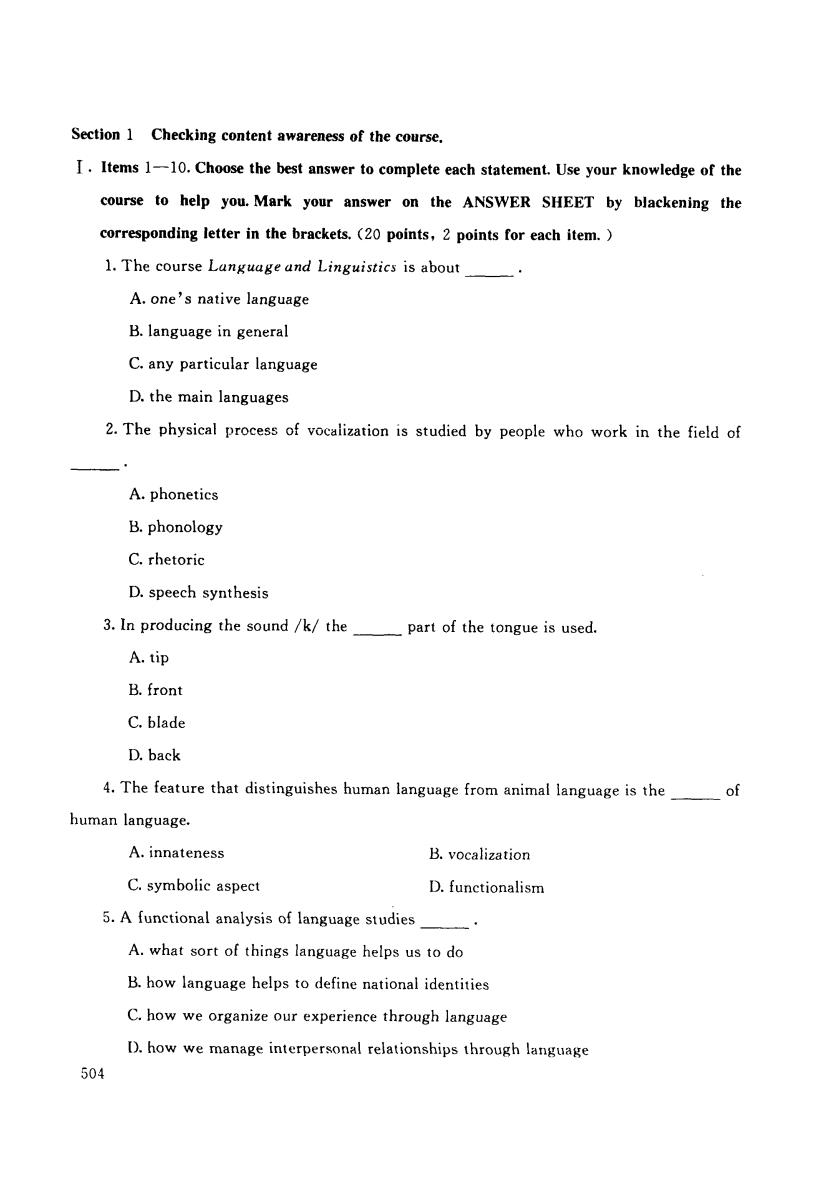
Section 1 Checking content awareness of the course. I.Items 1-10.Choose the best answer to complete each statement.Use your knowledge of the course to help you.Mark your answer on the ANSWER SHEET by blackening the corresponding letter in the brackets.(20 points,2 points for each item. 1.The course Language and Linguistics is about A.one's native language B.language in general C.any particular language D.the main languages 2.The physical process of vocalization is studied by people who work in the field of A.phonetics B.phonology C.rhetoric D.speech synthesis 3.In producing the sound /k/the part of the tongue is used. A.tip B.front C.blade D.back 4.The feature that distinguishes human language from animal language is the of human language. A.innateness B.vocalization C.symbolic aspect D.functionalism 5.A functional analysis of language studies A.what sort of things language helps us to do B.how language helps to define national identities C.how we organize our experience through language D.how we manage interpersonal relationships through language 504
Section 1 Checking content awareness of the course. I.Items 1一10. Choose the best answer to complete each statement. Use your knowledge of the course to help you. Mark your answer on the ANSWER SHEET by blackening the corresponding letter in the brackets. (20 points, 2 points for each item.) 1. The course Language and Linguistics is about A. one's native language B. language in general C. any particular language D. the main languages 2. The physical process of vocalization is studied by people who work in the field of A. phonetics B. phonology C. rhetoric D. speech synthesis 3. In producing the sound /k/ the part of the tongue is used. A. tip B. front C. blade D. back 4. The feature that distinguishes human language from animal language is the_ of human language. A. innateness B. vocalization C. symbolic aspect D. functionalism 5. A functional analysis of language studies A. what sort of things language helps us to do B. how language helps to define national identities C. how we organize our experience through language [).how we manage interpersonal relationships through language 504
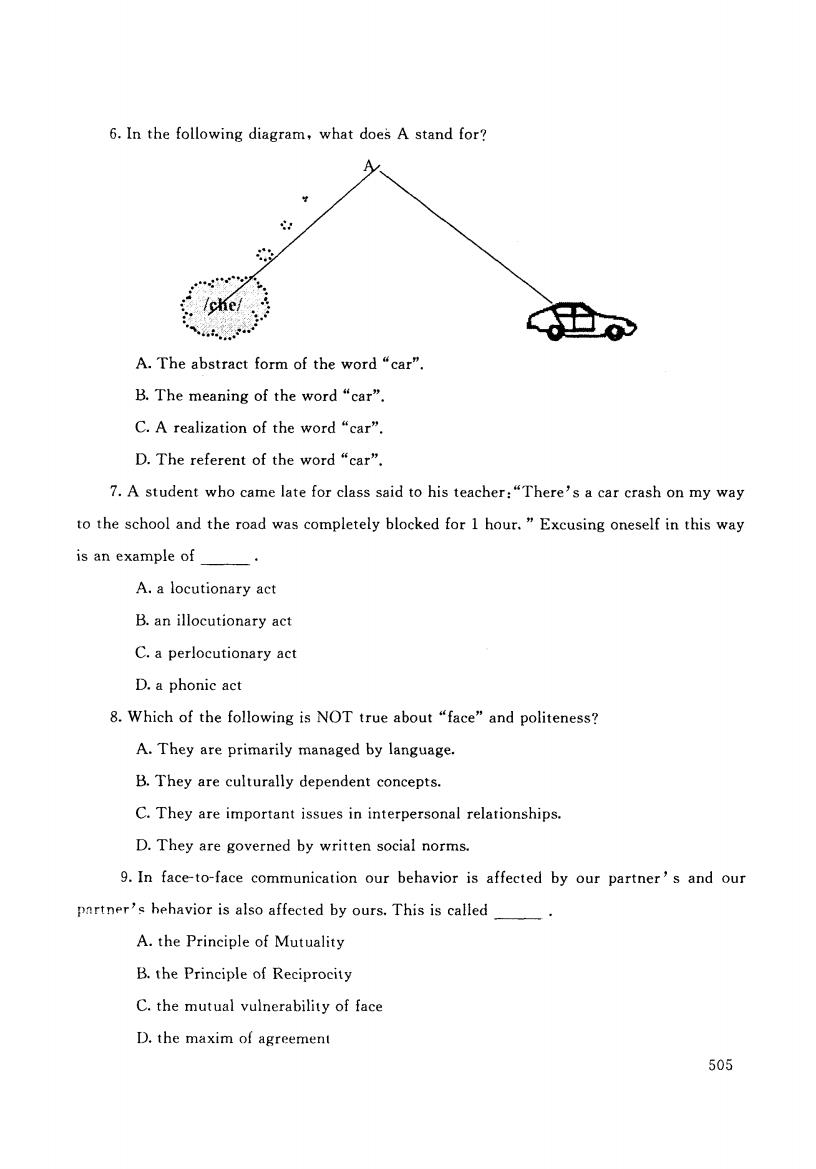
6.In the following diagram,what does A stand for? /che/ 田 A.The abstract form of the word“car”. B.The meaning of the word“car”. C.A realization of the word“car”. D.The referent of the word“car”. 7.A student who came late for class said to his teacher:"There's a car crash on my way to the school and the road was completely blocked for 1 hour."Excusing oneself in this way is an example of. A.a locutionary act B.an illocutionary act C.a perlocutionary act D.a phonic act &.Which of the following is NOT true about“face”and politeness? A.They are primarily managed by language. B.They are culturally dependent concepts. C.They are important issues in interpersonal relationships. D.They are governed by written social norms. 9.In face-to-face communication our behavior is affected by our partner's and our partner's hehavior is also affected by ours.This is called A.the Principle of Mutuality B.the Principle of Reciprocity C.the mutual vulnerability of face D.the maxim of agreement 505
6. In the following diagram, what doe's A stand for? … 了 犷少 、石气 A. The abstract form of the word "car". B. The meaning of the word "car". C. A realization of the word "car". D. The referent of the word "car". 7. Astudent who came late for class said to his teacher: "There's a car crash on my way to the school and the road was completely blocked for 1 hour.”Excusing oneself in this way is an example of A. a locutionary act B. an illocutionary act C. a perlocutionary act D. a phonic act 8. Which of the following is NOT true about "face" and politeness? A. They are primarily managed by language. B. They are culturally dependent concepts. C. They are important issues in interpersonal relationships. D. They are governed by written social norms. 9. In face-to-face communication our behavior is affected by our partner’s and our pnrtnpr';he.havior is also affected by ours. This is called A. the Principle of Mutuality B. the Principle of Reciprocity C. the mutual vulnerability of face D. the maxim of agreement 505
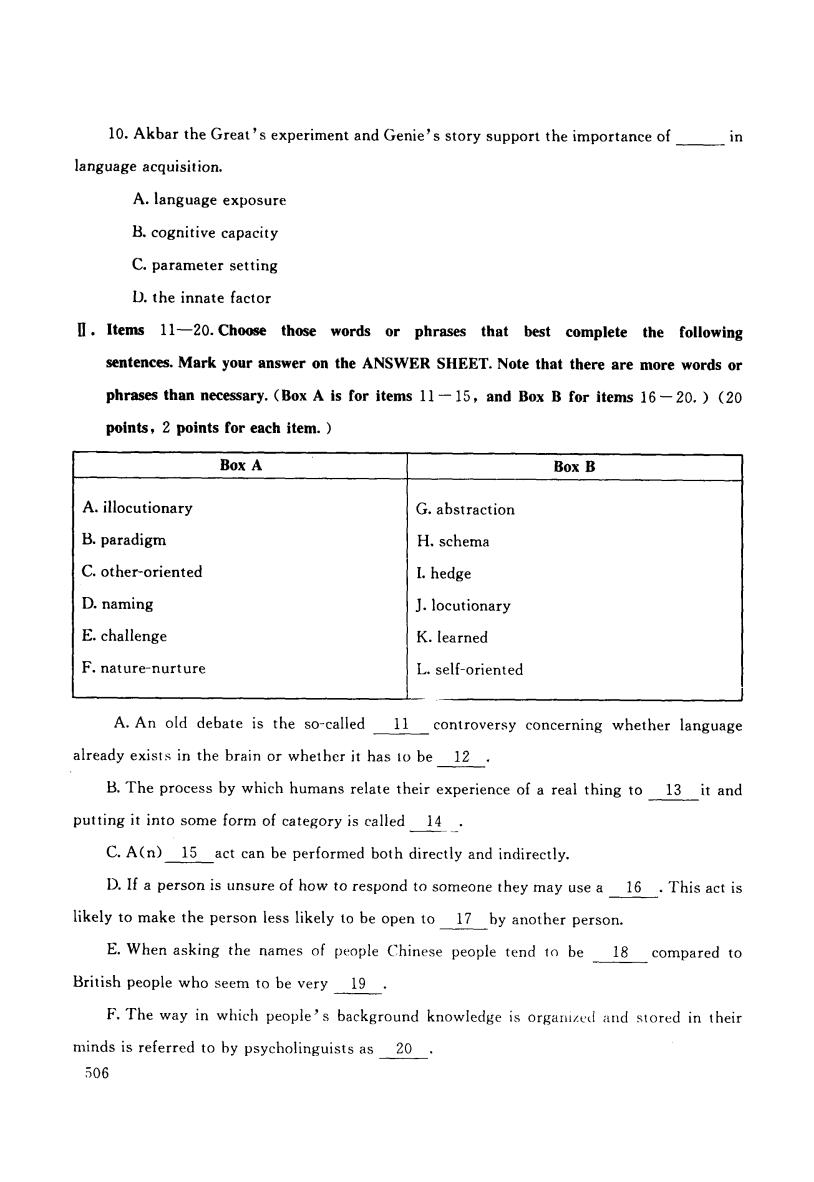
10.Akbar the Great's experiment and Genie's story support the importance of in language acquisition. A.language exposure B.cognitive capacity C.parameter setting D.the innate factor II.Items 11-20.Choose those words or phrases that best complete the following sentences.Mark your answer on the ANSWER SHEET.Note that there are more words or phrases than necessary.(Box A is for items 11-15,and Box B for items 16-20.)(20 points,2 points for each item. Box A Box B A.illocutionary G.abstraction B.paradigm H.schema C.other-oriented L.hedge D.naming J.locutionary E.challenge K.learned F.nature-nurture L.self-oriented A.An old debate is the so-called 11 controversy concerning whether language already exists in the brain or whether it has to be 12 B.The process by which humans relate their experience of a real thing to 13 it and putting it into some form of category is called 14. C.A(n)15 act can be performed both directly and indirectly. D.If a person is unsure of how to respond to someone they may use a 16.This act is likely to make the person less likely to be open to 17 by another person. E.When asking the names of people Chinese people tend to be 18 compared to British people who seem to be very 19. F.The way in which people's background knowledge is organized and stored in their minds is referred to by psycholinguists as 20. 506
10. Akbar the Great’s experiment and Genie's story support the importance of_ in language acquisition. A. language exposure B. cognitive capacity C. parameter setting D. the innate factor I.Items 11-20. Choose those words or phrases that best complete the following sentences. Mark your answer on the ANSWER SHEET. Note that there are more words or phrases than necessary. (Box A is for items 11一15,and Box B for items 16一20.)(20 points, 2 points for each item.) ‘一 ’.-一’一’一Box A ’一一 ~一--1一一一一一一一 Box B一一一一一一门 A. illocutionary B. paradigm C. other-oriented D. naming E. challenge F. nature-nurture G. abstraction H. schema J .hedge .locutionary K.learned L. self-oriented ‘一一一一一一一-一一一一一一一 _ _ _ _ .… … i A. An old debate is the so-called一卫一 controversy concerning whether language already exists in the brain or whether it has to be 12 13. The process by which humans relate their experience of a real thing to 13 it and putting it into some form of category is called 14 C. A(n)一 15一 act can be performed both directly and indirectly. D. If a person is unsure of how to respond to someone they may use a 16 .This act is likely to make the person less likely to be open to 17 by another person. E. When asking the names of people Chinese people tend to be 18 compared to British people who seem to be very 19 F. The way in which people’s background knowledge is organizes( and stored in their minds is referred to by psycholinguists as 20 506
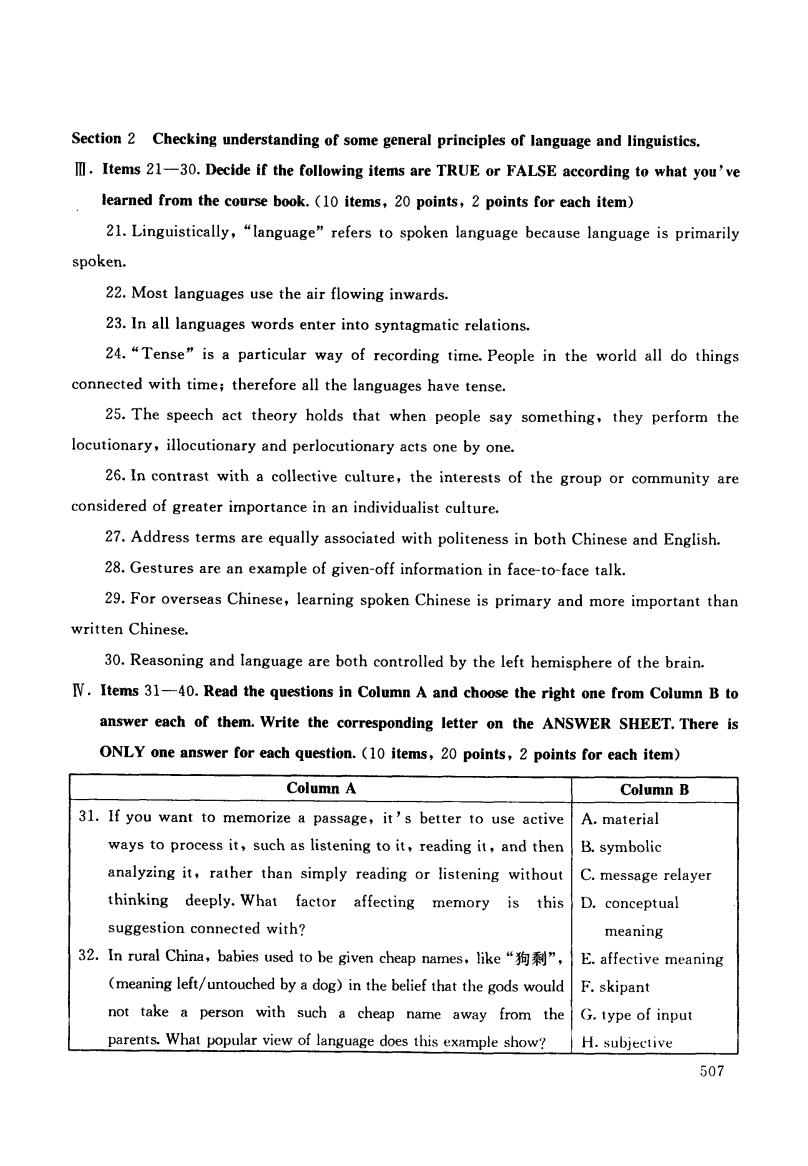
Section 2 Checking understanding of some general principles of language and linguistics. II.Items 21-30.Decide if the following items are TRUE or FALSE according to what you've learned from the course book.(10 items,20 points,2 points for each item) 21.Linguistically,"language"refers to spoken language because language is primarily spoken. 22.Most languages use the air flowing inwards. 23.In all languages words enter into syntagmatic relations. 24."Tense"is a particular way of recording time.People in the world all do things connected with time;therefore all the languages have tense. 25.The speech act theory holds that when people say something,they perform the locutionary,illocutionary and perlocutionary acts one by one. 26.In contrast with a collective culture,the interests of the group or community are considered of greater importance in an individualist culture. 27.Address terms are equally associated with politeness in both Chinese and English. 28.Gestures are an example of given-off information in face-to-face talk. 29.For overseas Chinese,learning spoken Chinese is primary and more important than written Chinese. 30.Reasoning and language are both controlled by the left hemisphere of the brain. IV.Items 31-40.Read the questions in Column A and choose the right one from Column B to answer each of them.Write the corresponding letter on the ANSWER SHEET.There is ONLY one answer for each question.(10 items,20 points,2 points for each item) Column A Column B 31.If you want to memorize a passage,it's better to use active A.material ways to process it,such as listening to it,reading it,and then B.symbolic analyzing it,rather than simply reading or listening without C.message relayer thinking deeply.What factor affecting memory is this D.conceptual suggestion connected with? meaning 32.In rural China,babies used to be given cheap names,ike“狗剩”, E.affective meaning (meaning left/untouched by a dog)in the belief that the gods would F.skipant not take a person with such a cheap name away from the G.type of input parents.What popular view of language does this example show? H.subjective 507
Section 2 Checking understanding of some general principles of language and linguistics. II·Items 21-30. Decide if the following items are TRUE or FALSE according to what you’ve learned from the course book.(10 items, 20 points, 2 points for each item) 21. Linguistically, "language" refers to spoken language because language is primarily spoken. 22.Most languages use the air flowing inwards. 23.Inall languages words enter into syntagmatic relations. 24. "Tense" is a particular way of recording time. People in the world all do things connected with time; therefore all the languages have tense. 25.The speech act theory holds that when people say something, they perform the locutionary, illocutionary and perlocutionary acts one by one. 26.In contrast with a collective culture, the interests of the group or community are considered of greater importance in an individualist culture. 27. Address terms are equally associated with politeness in both Chinese and English. 28. Gestures are an example of given-off information in face-to-face talk. 29. For overseas Chinese, learning spoken Chinese is primary and more important than written Chinese. 30.Reasoning and language are both controlled by the left hemisphere of the brain. W.Items 31-40. Read the questions in Column A and choose the right one from Column B to answer each of them. Write the corresponding letter on the ANSWER SHEET. There is ONLY one answer for each question.(10 items, 20 points, 2 points for each item) Column A Column B 31. If you want to memorize a passage, it’s better to use active ways to process it,such as listening to it,reading it,and then analyzing it,rather than simply reading or listening without thinking deeply. What factor affecting memory is this suggestion connected with? 32. In rural China, babies used to be given cheap names, like“狗剩”, (meaning left/untouched by a dog) in the belief that the gods would not take a person with such a cheap name away from the parents. What popular view of language does this example show? A. material B. symbolic C. message relayer D. conceptual meaning E. affective meaning F. skipant G. type of input H. subjective 507
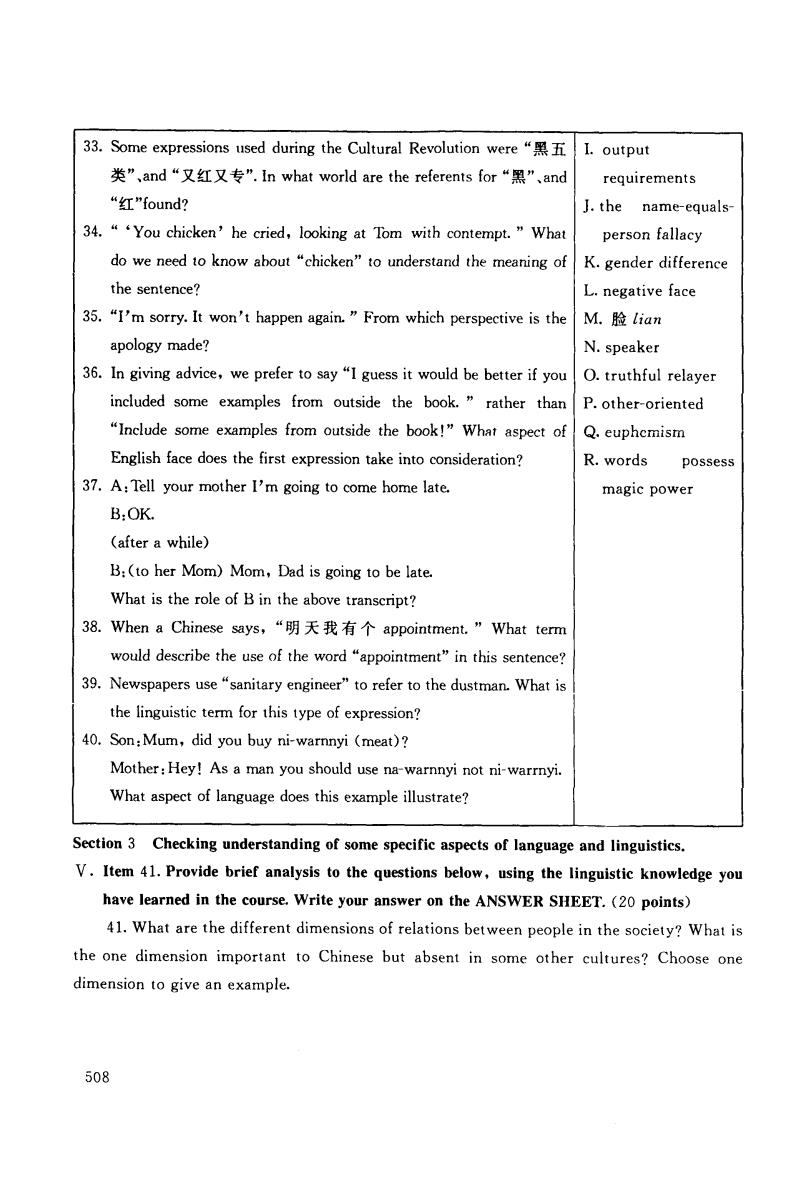
33.Some expressions used during the Cultural Revolution were“黑五 I.output 类”、and“又红又专”.in what world are the referents for“黑”、and requirements “红”found? J.the name-equals- 34."You chicken'he cried,looking at Tom with contempt."What person fallacy do we need to know about "chicken"to understand the meaning of K.gender difference the sentence? L.negative face 35."I'm sorry.It won't happen again."From which perspective is the M.脸lian apology made? N.speaker 36.In giving advice,we prefer to say "I guess it would be better if you O.truthful relayer included some examples from outside the book.rather than P.other-oriented "Include some examples from outside the book!"What aspect of Q.euphemism English face does the first expression take into consideration? R.words possess 37.A:Tell your mother I'm going to come home late. magic power B:OK. (after a while) B:(to her Mom)Mom,Dad is going to be late. What is the role of B in the above transcript? 38.When a Chinese says.,“明天我有个appointment..”What term would describe the use of the word "appointment"in this sentence? 39.Newspapers use"sanitary engineer"to refer to the dustman.What is the linguistic term for this type of expression? 40.Son:Mum,did you buy ni-warnnyi (meat)? Mother:Hey!As a man you should use na-warnnyi not ni-warrnyi. What aspect of language does this example illustrate? Section 3 Checking understanding of some specific aspects of language and linguistics. V.Item 41.Provide brief analysis to the questions below,using the linguistic knowledge you have learned in the course.Write your answer on the ANSWER SHEET.(20 points) 41.What are the different dimensions of relations between people in the society?What is the one dimension important to Chinese but absent in some other cultures?Choose one dimension to give an example. 508
33. Some expressions used during the Cultural Revolution were“黑五 类”,and“又红又专”.In what world are the referents for“黑”,and “红”found? 34.“‘You chicken’he cried, looking at Tom with contempt.”What do we need to know about "chicken" to understand the meaning of the sentence? 35. "I'm sorry. It won't happen again.,From which perspective is the apology made? 36. In giving advice, we prefer to say "I guess it would be better if you included some examples from outside the book.” rather than "Include some examples from outside the book!”What aspect of English face does the first expression take into consideration? 37. A:Tell your mother I'm going to come home late. B: OK. (after a while) B: (to her Mom) Mom, Dad is going to be late. What is the role of B in the above transcript? 38. When a Chinese says,“明 天 我有 个 appointment. " What term woulddescribe the use of the word "appointment" in this sentence? 39. Newspapers use "sanitary engineer" to refer to the dustman. What is the linguistic term for this type of expression? 40. Son:Mum, did you buy ni-warnnyi (meat)? Mother: Hey! As a man you should use na-warnnyi not ni-warrnyi. What aspect of language does this example illustrate? I. output requirements J. the name-equals- person fallacy K. gender difference L. negative face M.脸 lion N. speaker O. truthful relayer P. other-oriented Q. euphemism R. words possess magic power Section 3 Checking understanding of some specific aspects of language and linguistics. V.Item 41. Provide brief analysis to the questions below, using the linguistic knowledge you have learned in the course. Write your answer on the ANSWER SHEET. (20 points) 41. What are the different dimensions of relations between people in the society? What is the one dimension important to Chinese but absent in some other cultures? Choose one dimension to give an example. 508
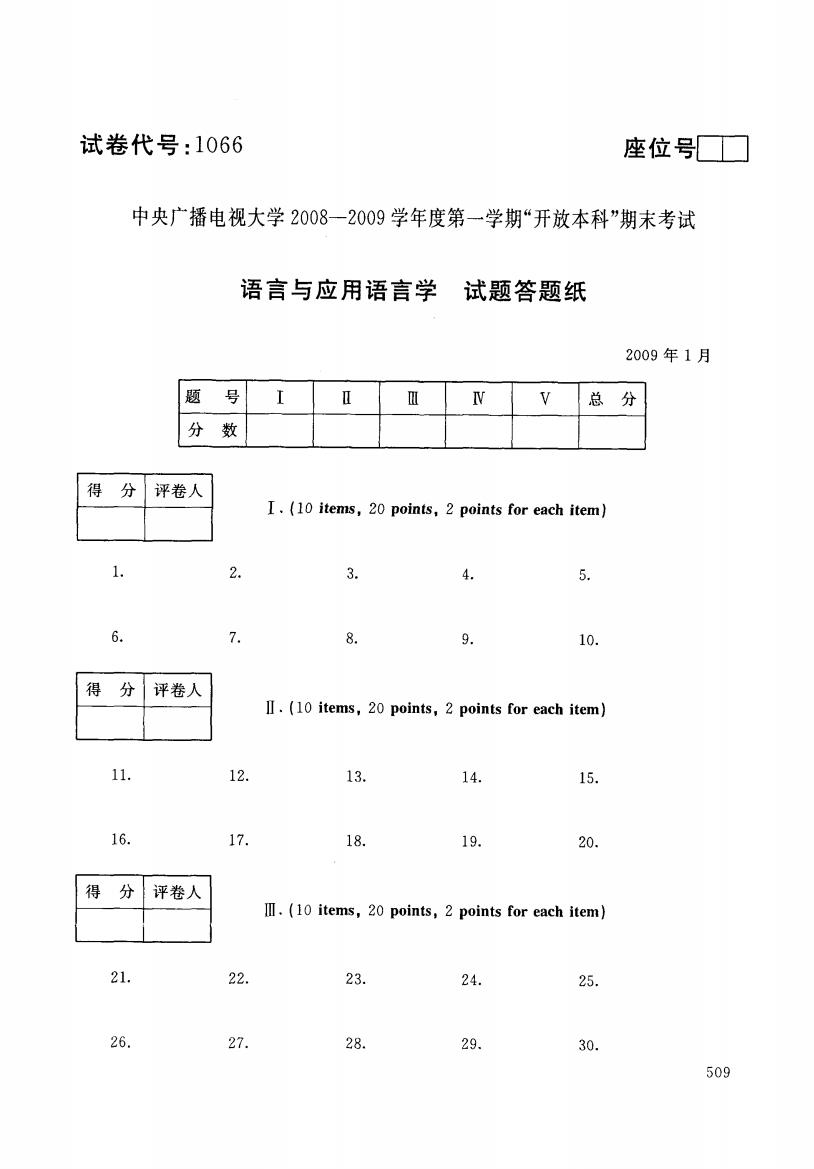
试卷代号:1066 座位号☐口 中央广播电视大学2008一2009学年度第一学期“开放本科”期末考试 语言与应用语言学 试题答题纸 2009年1月 题 号 I Ⅱ 瓜 W V 总 分 分 数 得分 评卷人 I.(10 items,20 points,2 points for each item) 1. v 3. 4. 5. 6. 7. 8. 9 10. 得分 评卷人 II.(10 items,20 points,2 points for each item) 11. 12. 13. 14. 15. 16. 17. 18. 19. 20. 得分 评卷人 III.(10 items,20 points,2 points for each item) 21. 22. 23. 24. 25 26. 27. 28. 29. 30. 509
试卷代号:1066 座位号口二} 中央广播电视大学2008-2009学年度第一学期“开放本科”期末考试 语言与应用语言学 试题答题纸 2009年 1月 题 号 I I 班 N V 总 分 分 数 得 分 评卷人 I,(10 items, 20 points, 2 points for each item) 10 得 分 评卷人 I。(10 items, 20 points, 2 points for each item) 11 12 13 14 15 16 17 18 19 20 得 分 !评卷人 IH。(10 items, 20 points, 2 points for each item) 21 22 23 24 25 26 27 28 29 30 509
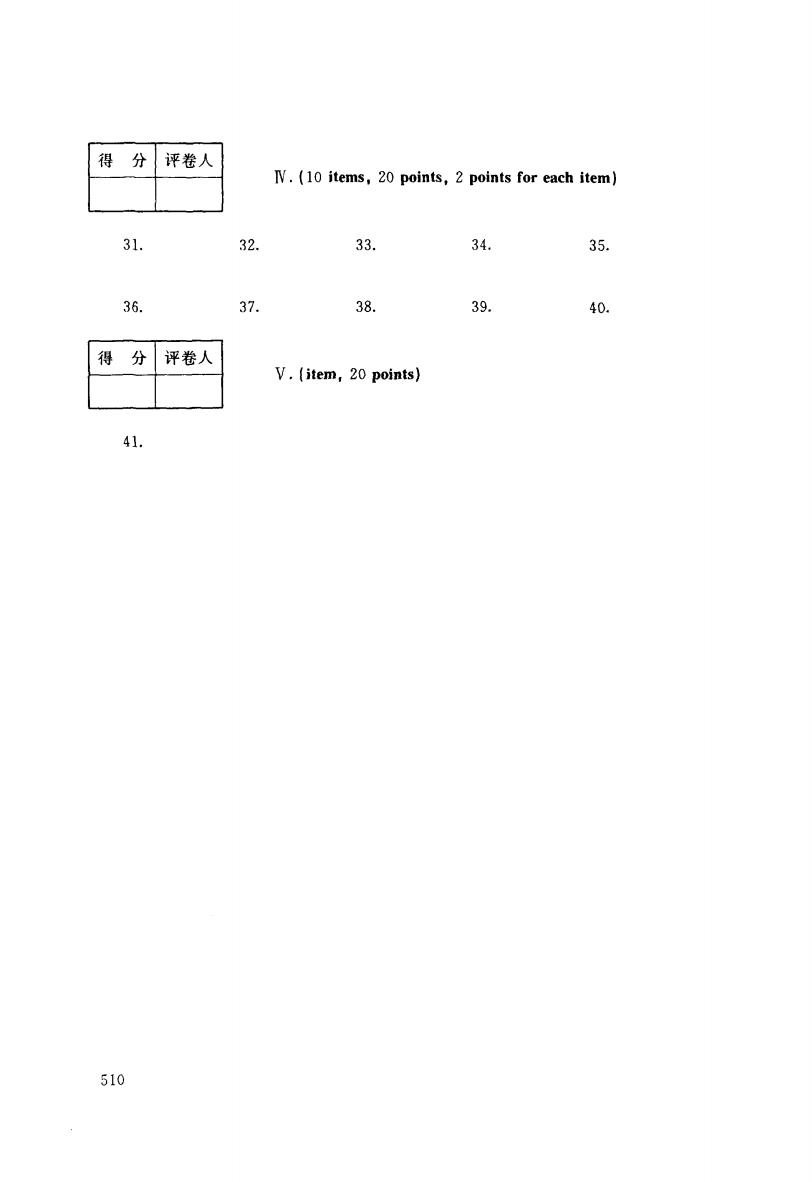
得分 评卷人 IV.(10 items,20 points,2 points for each item) 31. 32. 33. 34. 35. 36. 37. 38. 39. 40. 得分 评卷人 V.(item,20 points) 41. 510
得 分 评卷人 W.(10 items, 20 points, 2 points for each item) 31 32 33 34 35 36 37 38 39 40 得 分 评卷人 V。(item, 20 points) 41 510

试卷代号:1066 中央广播电视大学2008一2009学年度第一学期“开放本科”期末考试 语言与应用语言学试题答案及评分标准 (供参考) 2009年1月 I.(10 items,20 points,2 point for each item) 1.B 2.A 3.D 4.C 5.A 6.A 7.B 8.D 9.A 10.A II.(10 items,20 points,2 points for each item) 11.F 12.K 13.D 14.G 15.A 16.I 17.E 18.C 19.L 20.H III.(10 items,20 points,2 point for each item) 21.F 22.F 23.T 24.F 25.F 26.F 27.F 28.T 29.T 30.T IV.(10 items,20 points,2 points for each item) 31.G 32.J 33.H 34.E 35.N 36.L 37.C 38.F 39.Q 40.K V.(20 points) (问题) 41.What are the different dimensions of relations between people in the society?What is the one dimension important to Chinese but absent in some other cultures?Choose one dimension to give an example. (答案)》 41.Relations between people in society can be analyzed in terms of (1)familiarity (1 point) (2)emotional distance (1 point) 511
试卷代号:1066 中央广播电视大学2008--2009学年度第一学期“开放本科”期末考试 语言与应用语言学 试题答案及评分标准 (供参考) 2009年 1月 I.(10 items, 20 points, 2 point for each item) 1. B 6.A 2. A 3. D 4. C 5.A 7. B 8. D 9. A 10. A items, 20 points, 2 points for each item) 13. D 18. C 14. G 19.L 15. A 20. H : n乙 门了 11 ,.齐 F I flT items,20 points, 2 point for each item) 25.F 30. T F T 月 性 0 甘 9 口 Q 自 : 勺 d O U Q 自 Q 自 , 曰 , 奋 Q 自 9 口 N items, 20 points, 2 points for each item) G V L points) 32. 7 37. C 33. H 38. F 34. E 39. Q 35.N 40. K … … n U li 尺 U C 分 11 八t) n ︺ 1 1 八b 六U 1 1 11 ,. 干 1 1 0 自 0 自 1 1 O d QJ O 白 了‘、 了‘、 了 、 了、 : ‘ . (间题) 41.What are the different dimensions of relations between people in the society? What is the one dimension important to Chinese but absent in some other cultures? Choose one dimension to give an example. (答案) 41.Relations between people in society can be analyzed in terms of (1)familiarity(1 point) (2)emotional distance(1 point) 511
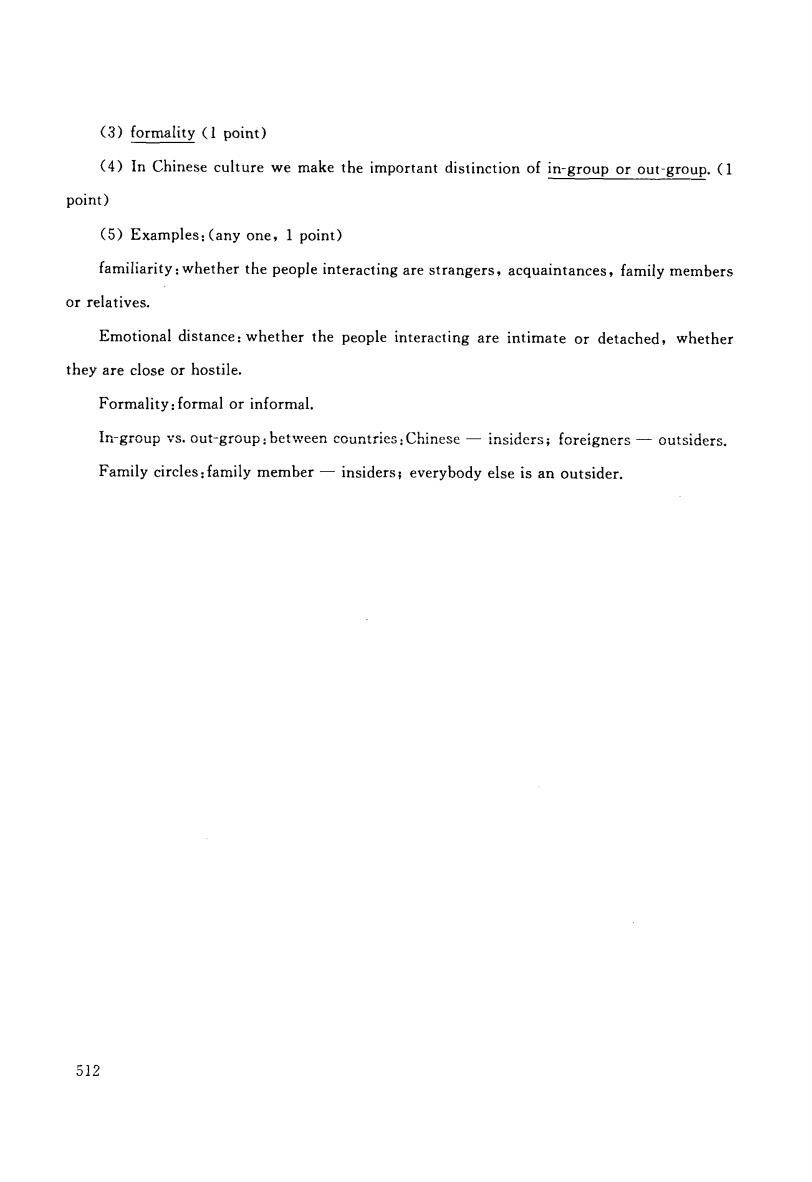
(3)formality (1 point) (4)In Chinese culture we make the important distinction of in-group or out-group.(1 point) (5)Examples:(any one,1 point) familiarity:whether the people interacting are strangers,acquaintances,family members or relatives. Emotional distance:whether the people interacting are intimate or detached,whether they are close or hostile. Formality:formal or informal. In-group vs.out-group:between countries:Chinese-insiders;foreigners-outsiders. Family circles:family member-insiders;everybody else is an outsider. 512
(3) formality(I point) (4) In Chinese culture wemake the important distinction of in-group or out-group.(1 point) (5) Examples: (any one, 1 point) familiarity:whether the people interactingare strangers,acquaintances,family members or relatives. Emotional distance:whether the people interacting are intimate or detached,whether they are close or hostile. Formality: formal or informal. In-group vs. out-group:between countries:Chinese insiders; foreigners一 outsiders. Family circles:family member一 insiders; everybody else is an outsider. 512